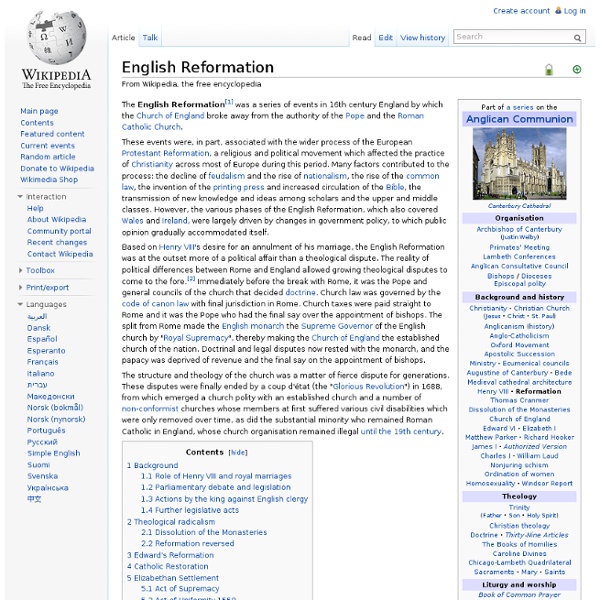English Reformation

The Reformation
Help support New Advent and get the full contents of this website as an instant download. Includes the Catholic Encyclopedia, Church Fathers, Summa, Bible and more — all for only $19.99... The usual term for the religious movement which made its appearance in Western Europe in the sixteenth century, and which, while ostensibly aiming at an internal renewal of the Church, really led to a great revolt against it, and an abandonment of the principal Christian beliefs. Causes of the Reformation The causes of the great religious revolt of the sixteenth century must be sought as far back as the fourteenth. Since the barbarian invasions the Church had effected a complete transformation and revival of the races of Western Europe, and a glorious development of religious and intellectual life. Closely connected with the above were various abuses in the lives of the clergy and the people. The Renaissance and Humanism partly introduced and greatly fostered these conditions.
Glossary Definition: Reformation
A term covering a number of changes in Western Christianity (Europe) between the 14th and 17th centuries, resulting in the split in Christianity between Roman Catholicism and Protestantism. The Reformation, widely conceived, was a reaction against the hierarchical and legalistic structures of the Papacy and the Roman Catholic Church. Reformers rallied against the Roman Catholic Church's dogmatic theology, economic and religious exploitation of the common masses, and colonialization and conquest of indigenous peoples. Most fundamentally, the Reformation challenged the Papacy's claims of divine authorization and infallibility. One particularly well-known Catholic method of exploitation in the Middle Ages was the practice of selling indulgences, a monetary payment of penalty which, supposedly, absolved one of past sins and/or released one from purgatory after death.
The Catholic Reformation
The Catholic Reformation was the intellectual counter-force to Protestantism. The desire for reform within the Catholic Church had started before the spread of Luther. Many educated Catholics had wanted change - for example, Erasmus and Luther himself, and they were willing to recognise faults within the Papacy. During the Cl5, society was changing. In the Cl3, St. But Augustinian beliefs were still strong and alive in Catholic centres of learning. Francisco de Suarez and Luis de Molin (both Jesuits) both tried to bridge the gap between Thomism and Augustinianism by claiming that Man had freedom of choice but ultimately God was omnipotent. Some Catholic reformers were also influenced by late Medieval mysticism such as Master Eckhardt and Thomas a Kempis. Many old monastic orders had sunk to levels of unacceptable standards. The Catholic Reformation relied on individuals. These were men of great intellect and thought who never wavered in adherence to the Catholic Church.
History - An Overview of the Reformation
Related:
Related:



